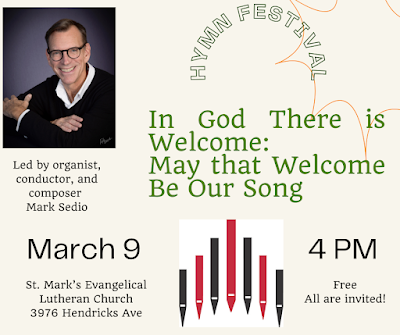OPENING VOLUNTARY Be Thou My Vision James Pethel
See the text and tune at ELW 793.
See the text and tune at ELW 793.
This ancient Irish tune with a text by Eleanor Hull is a favorite hymn of many. I chose to play a setting of Slane because we'll hear a different setting of the text by John Rutter at the musical offering.
GATHERING HYMN Lord of Glory, You Have Bought Us (Hyfrydol) ELW 707
How far is it from Ireland to Wales? It's about 108 miles, but this morning we'll close that gap in about 2 minutes. The tune for our Gathering Hymn is Welsh. Both Ireland and Wales have Celtic roots.
In today's gospel reading, Jesus tells how to treat our enemies - we are to love them, do good to them, and bless them. This can be a tall, tall order. But we acknowledge, in the third stanza of this hymn, that our love can do it with the love of Jesus.
HYMN OF THE DAY Light Dawns on a Weary World (Temple of Peace) ELW 726
In today's gospel reading, Jesus tells how to treat our enemies - we are to love them, do good to them, and bless them. This can be a tall, tall order. But we acknowledge, in the third stanza of this hymn, that our love can do it with the love of Jesus.
HYMN OF THE DAY Light Dawns on a Weary World (Temple of Peace) ELW 726
For many of the hymns we sing, the texts are written to go with a meter, not with a tune. That is not the case here with this hymn. The composer, William P. Rowan, wrote about 18 hymntunes with no texts in mind, so that the music, and not the text, would "animate the creative process. He shared this tune with Mary Louise Bringle who called it "love at first listen."
Bringle drew on images from Isaiah and wrote a refrain that shows humans living in joy and peace, not just with each other, but with all creation.
Bringle drew on images from Isaiah and wrote a refrain that shows humans living in joy and peace, not just with each other, but with all creation.
MUSICAL OFFERING Be Thou My Vision John Rutter
John Rutter's original music for this much-loved text still manages to maintain a Celtic feel. The piano imitates both an Irish flute and a Celtic harp to accompany a melody that sounds like it might be coming from mists over Loch Lomond.
COMMUNION HYMNS
In All Our Grief (Fredricktown) ELW 615
In today's gospel reading, Jesus teaches us how to live together. This hymn expresses our remorse when we fail to live that way. Its refrain combines elements of two of our liturgical songs - the Kyrie (Lord, have mercy) and the Agnus Dei (Lamb of God).
Lord, have mercy. Christ, have mercy. Lord, grant us peace.
Lord, have mercy. Christ, have mercy. Lord, grant us peace.
Jesus, Remember Me ELW 616
The beauty of this hymn is that you don't need to carry a hymnal with you. Sing it once, maybe twice, and you'll be able to sing it from memory. You can turn it into sung prayer by closing the book and continuing to sing as you approach the Lord's table, and as you return to your seat.
SENDING HYMN God, When Human Bonds Are Broken (Merton) ELW 603
CLOSING VOLUNTARY Trumpet Tune on "Freu dich sehr"
Jerry Westenkuehler
See the text and tune at ELW 783.
See the text and tune at ELW 783.
DON'T MISS THE SAN MARCO CHAMBER MUSIC SOCIETY THIS SUNDAY, 02/23/2025

















